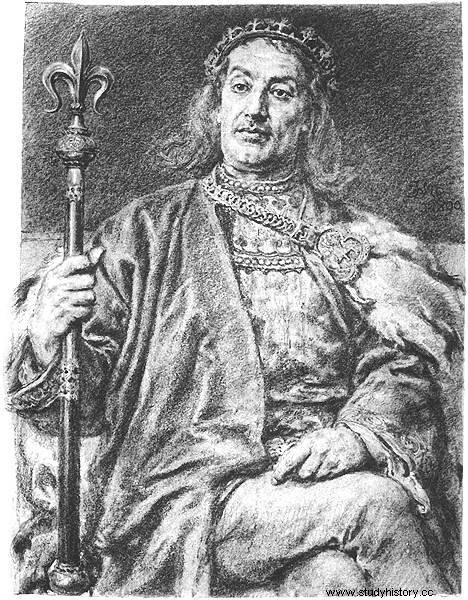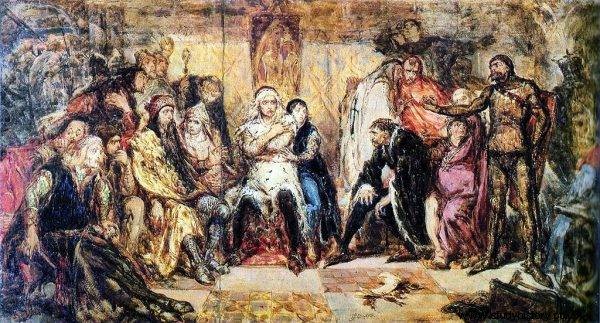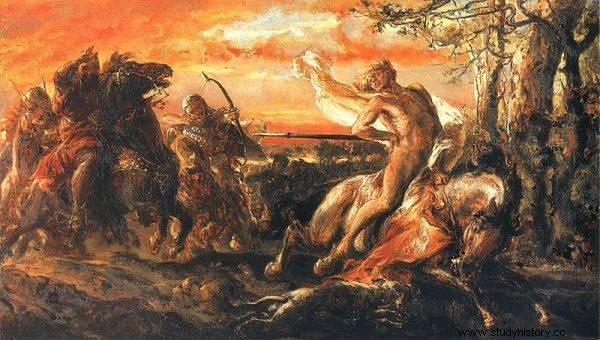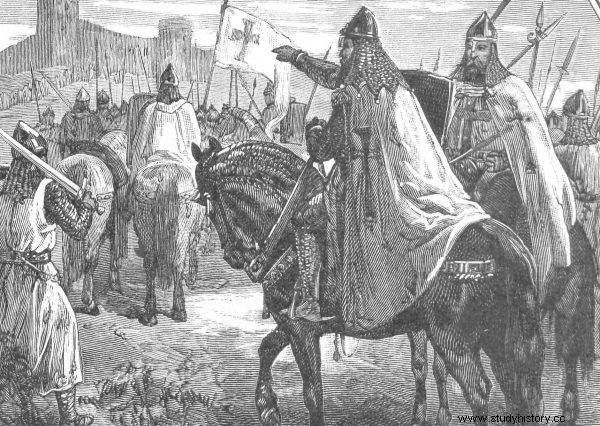Supposedly he died with a knife in his gut, killed by a cook whom he tried to rape. Władysław Laskonogi is the most controversial of the district princes.
In addition to adoring the pleasures of the body, Laskonogi also has a more serious objection. He may have been involved in the most famous attack in Piast Poland - in Gąsawa, on Prince Leszek the White.
Ruler of Greater Poland
Władysław was born as the third, youngest son of Mieszko Stary. He took over power in Wielkopolska after him. Throughout his political career, Laskonogi (he owed the nickname to his unusually long and skinny legs) fought two main opponents - nephew Władysław Odonice and archbishop of Gniezno, Henryk Kietlicz.

Władysław Laskonogi was born as the third, youngest son of Mieszko Stary. He took over power in Greater Poland after him.
Odonic was the only male descendant of the Mieszko family after the other Laskonogi brothers. Hence, the interests of both of them necessarily clashed with each other. A much younger nephew began to complain to "his" part of the lands left by Mieszko Stary . At the same time, he was extremely efficient. At the age of only 16, he gained supporters in the form of some of the powerful from Poznań, and above all, an extremely strong figure - metropolitan Henryk Kietlicz. The mighty bishop, in turn, had a reason to enter into an alliance with the teenager. He fought for the influence of the Church. He demanded the limitation of princely power and the establishment of church privileges. He wanted it to be solely the responsibility of the clergy to be nominated to the office of bishop.
Curse
The younger Piast princes willingly made concessions. It was different with Laskonogi. He cared deeply about his position and influence. It was on such soil that the allies started a revolt in the Poznań district. The plot, however, was not well prepared. The archbishop and young Odonic had to flee Poznań. Even the curse that the bishop cast on Laskonogi in 1206 did not help. The conspirators found shelter at the court of Henry the Bearded, who ruled the Silesian district at that time. The curse even rubbed against Pope Innocent III, but did not have the expected effect. The prince kept his power and did not have to complain. This is because the faithful bishop of Poznań, Arnold II, stayed with him.
This state of affairs did not last long. After the council of Lateran in 1215, the position of archbishop strengthened. Laskonogi gave way to Odonic, giving him part of the lands. Previously, compensated a powerful clergyman for the wrongs suffered . There is no doubt that he did so for purely political reasons. Unlike many other rulers of the era, he was not distinguished by piety. As a ruler, he did not fund new churches, monasteries, etc.
The situation of Bishop Kietlicz was reversed when his powerful protector, Pope Innocent, died. It was then that Laskonogi began the offensive. First concluded the so-called an alliance for survival with Leszek Biały, ruling the senior district. He assumed that in the event of the death of one of the princes and leaving the district without a male heir, the other ally would take over his land. Such a state of affairs, as it were, "disinherited" Władysław Odonic, who ruled in Kalisz at the time, from Wielkopolska which was the first in line to take over all the lands. Soon the allies drove Odonic out of the country. Soon after, the problem of the powerful archbishop was "solved". Kietlicz died. Laskonogi put "his" man in his place - Wincenty from Niałek.
The crime in Gąsawa
The ambitious Odonic - even though he was in a lost position - did not give up his plans to regain Wielkopolska. For this, he found an extremely strong ally. It was Świętopełk, the Pomeranian prince from the Sobiesławice dynasty, striving with all his strength to become independent from the Piasts. He was given the power of the governor of the Baltic Sea by Leszek Biały. However, Świętopełk's ambitions were much greater therefore he supported the help-seeker Odonic. The latter took his daughter to wife.

The tense situation was to be relieved by the convention in Gąsawa in 1227
Soon Odonic's nephew began to strengthen on the border. He mastered Ujście nad Notecią and Nakło. He began to threaten the lands of Laskonogi. He tried to punish his rebellious nephew by force, but he suffered an unexpected defeat at Ujście. Then he turned to the other princes for help. The tense situation was to be relieved by the convention in Gąsawa in 1227 , convened on the initiative of Leszek Biały. And here we come to one of the most tragic and mysterious pages in the history of a neighborhood breakdown.
The attack in Gąsawa
Władysław Laskonogi did not participate in the convention, although the talks were largely devoted to his problems with his nephew. This is a mysterious absence. But there was Laskonogi's greatest opponent, Władysław Odonic (his presence is not certain) . The main enemy of the Piasts - the Pomeranian Świętopełk - did not participate in the talks. A whole crowd of officials came to the convention:clergy and powerful. And also the princes - Henryk the Bearded from Silesia, Leszek Biały who ruled the senior district and Konrad who was in charge of Mazovia.
The talks probably began on November 11, 1227, on St. Martin. On the third day of the convention, dramatic events took place early in the morning. When Prince Leszek Biały was relaxing in the bathhouse, a group of armed men attacked the participants of the convention . Henryk the Bearded was injured. The attackers attacked him while he was still in the sleeping chamber, in bed. Fortunately, one of the knights saved him from death. On the other hand, , shirtless Leszek Biały tried to escape from the bathhouse. He jumped on his horse and ran as fast as he could, but the killers' arrow reached him about two kilometers from Gąsawa.

Death of Leszek the White
Who was behind the attack? It is commonly believed that the invaders were sent by Świętopełk, probably not without Odonic's knowledge. Both had an obvious interest in removing the Piast allies. Świętopełk would become independent from the princes. Odonic would effectively weaken the influence of his main enemy - Laskonogi. Admittedly, just before the congress, the conspirators were supposed to divide, and Świętopełk was even supposed to occupy the town of Odonica in Nakło. However, researchers believe that it was a medieval false flag operation. A hoax, coined by both to give an alibi to Odonic should the attack succeed. At the crucial moment, Świętopełk was to be released from the stronghold, and his men were sent to murder the Piasts.
Killer?
There is, however, another hypothesis, which is supported by the mysterious absence of Laskonogi during the deliberations - in his case, after all. Well, according to the principle that the perpetrator is the one who benefits, it was the Duke of Greater Poland who could gain the most from the death of Leszek the White . Why? He was to take the throne in the Krakow district in the event that the senior ruler died without a male heir.
It is true that Leszek Biały had a son, but at the time of his death the boy was only one year old. So power under the agreement would still fall in the first place with Laskonogi. And so it happened. After the Gąsawa crime, the lascognees stood politically on long and thin legs. He claimed power in the senior district and even defeated his nephew in battle and captured him. It is true that Konrad Mazowiecki, the brother of the murdered Leszek the White, also raised claims to power in Krakow, but ultimately the mighty opted for Laskonogi through the election. Thus in a sense he became the first elected ruler in Poland. So if it was the prince of Greater Poland who was behind the Gąsawa attack, the crime would simply pay off for him.
The fall
Ultimately, however, Władysław Laskonogi lost many years of struggle with Odonice. He managed to escape from captivity and entered into an alliance with Konrad Mazowiecki, who was removed from Krakow. As a result, Laskonogi, fearing the loss of his native Greater Poland, asked the allied Henryk the Bearded to rule in Kraków . It did, but it did not prevent a defeat.

Ultimately, however, Władysław Laskonogi lost many years of struggle with Odonice.
Konrad managed to take the whole of Małopolska. At the same time, he imprisoned the Bearded (thanks to the intercession of the prince's wife - Saint Jadwiga - he was soon released). Then in alliance with Odonice he set off against Laskonogi to Wielkopolska , forcing him to flee to Silesia - to the freed Henryk. In spite of several attempts, he never regained control of his district. Soon after, in 1231, 70-year-old Laskonogi died in the Piast stronghold in Środa Śląska. If you believe the chronicler - in embarrassing circumstances.
Lover?
According to the Cistercian chronicler, Albery of Trois-Fontaines, the prince did not leave this world alone. He was stabbed to death by a German-born cook during an attempted rape. To this day, nothing else is known about this. Just like where the prince was buried is unknown. Some researchers believe that his grave should be found in Silesia, perhaps in Racibórz. Others believe that the ruler's remains were deposited in the monastery in Lubiń.
In the last moments of his life, was the prince really trying to experience bodily pleasure in an unworthy manner? A certain argument in favor of such a scenario are the records of the chronicler Jan Długosz, which were hundreds of years later. On the date 1229, i.e. during the offensive of Władysław Odonic against Laskonogi, he left the following note:
Laskonogs, because he knew that the uncertain and shaky loyalty of his subjects, who felt resentment and contempt for him for his filthy, debauched life and other acts unworthy of the prince, would not persist , not having the courage to fight the incoming nephew and mortal enemy, so that if he was abandoned by his own, he would not be captured, having abandoned the castles and strongholds in Greater Poland, he left and took refuge in the castle in Racibórz.
It follows from the text that the liking for the pleasures of the body was a trait of the prince that was well known and did not like him. On the other hand, Długosz, who wrote his chronicles several hundred years later, is not a very reliable historical source. He has been repeatedly accused of not avoiding distortions and mere propaganda. Długosz - as a clergyman - might not have liked the person of Laskonogi, who was not very religious and fought against the influence of the clergy. Perhaps, knowing the notes of a Cistercian from France, he additionally strengthened the negative image of the prince. Was it so? We do not know. In any case, the only account of Władysław's death to this day is the infamous story of rape.
